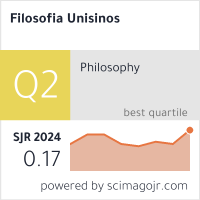Phenomenology of concealment and self-disillusionment in Kierkegaard
Abstract
This essay presents a critical analysis of the constitution of the “I” and the “other” as these are found in two of Kiekegaard’s most important texts, Works of Love, published in 1847, and Sickness unto Death, published in 1849. It particularly elucidates, with regard to the concepts of “I” and “other”, the nature of Kierkegaard’s discourse, which is based on a phenomenological strategy of reduplication that renders impossible every definition of the phenomena that departs from a positive stipulation of a conceptual identity. Hence, once one finds the presupposition of this strategy, that is to say, once one clarifies the essential features of the typically Christian phenomena, then it becomes possible to outline the faults and aporias advanced by Kierkegaard regarding the constitution of the subject or “I” and the relation between this “I” and the “other”. These faults or indeterminacies, which are the main topic of this essay, in their turn, seem to jeopardize not only a possible social theory – which Works of Love intends to develop – but, more fundamentally, the whole of Kierkegaard’s ethical project itself.
Key words: I, other, reduplication, constitution of the subject, ethics.Downloads
Metrics
Downloads
Published
How to Cite
Issue
Section
License
I grant the Filosofia Unisinos – Unisinos Journal of Philosophy the first publication of my article, licensed under Creative Commons Attribution license 4.0 (which allows sharing of work, recognition of authorship and initial publication in this journal).
I confirm that my article is not being submitted to another publication and has not been published in its entirely on another journal. I take full responsibility for its originality and I will also claim responsibility for charges from claims by third parties concerning the authorship of the article.










